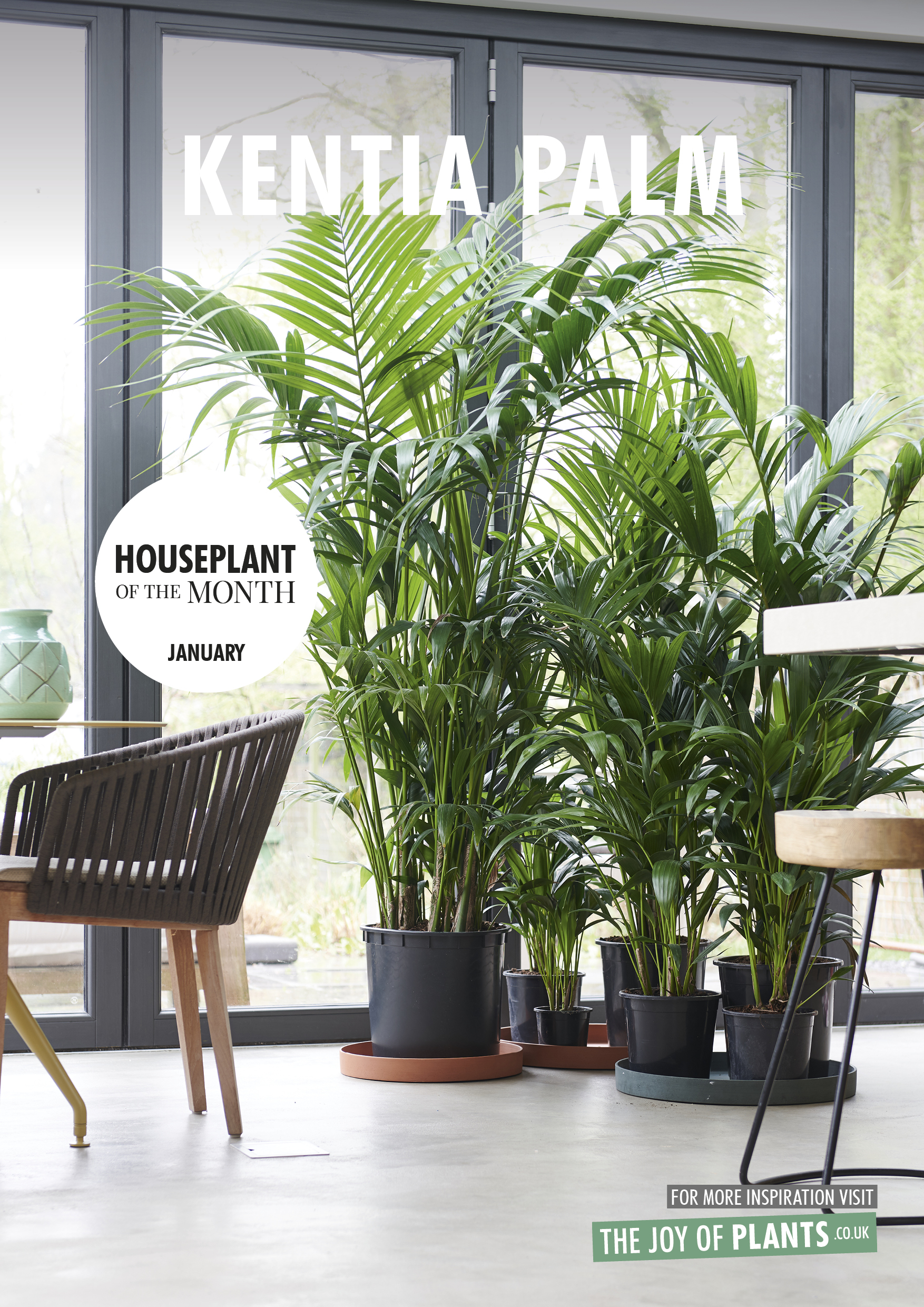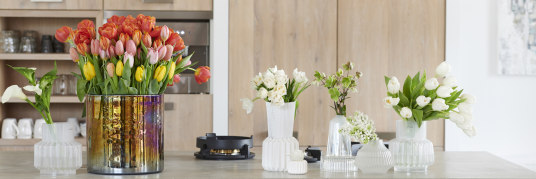January 2019: Kentia Palm Houseplant of the Month
The story of Kentia Palm
Kentia Palm (Howea forsteriana) is a plant with a relatively small base from which slender stems grow upwards bearing soft, elegant green palm leaves. It’s one of the few palms that thrives on little light, low humidity and cool rooms. Kentia Palm is also an attractive feature in the home: the light passes very attractively through the elegant leaves.
Kentia Palm (Howea forsteriana) is a plant with a relatively small base from which slender stems grow upwards bearing soft, elegant green palm leaves. It’s one of the few palms that thrives on little light, low humidity and cool rooms. Kentia Palm is also an attractive feature in the home: the light passes very attractively through the elegant leaves.
Origin
Kentia Palm is a member of the Palm family, and grows on Lord Howe Island east of Australia beneath the foliage of larger trees. This means that it’s used to getting little sunlight. In the wild the palm can reach a height of 18 metres and a width of 6 metres, with 3 metre long leaves. The cultivated variety sticks to a more modest scale.
Kentia Palm is a member of the Palm family, and grows on Lord Howe Island east of Australia beneath the foliage of larger trees. This means that it’s used to getting little sunlight. In the wild the palm can reach a height of 18 metres and a width of 6 metres, with 3 metre long leaves. The cultivated variety sticks to a more modest scale.
Low energy consumption
The palm trees are propagated from seed, and all the seed is still imported from Lord Howe Island so that authenticity is guaranteed. High temperatures are required to be able to interrupt the dormancy, up to 35-40°C. The entire process takes at least 30 weeks. The plant itself grows slowly - the cultivation time depends on the size and density of the plant. The denser a Kentia Palm is, the more seed has been used. The taller the plant, the older a Kentia Palm is. Even the smallest pot size is already almost a year old before it becomes available, whilst the larger specimens can easily take seven years to grow. This partly explains the relatively high price of Kentia Palms. One advantage is that the plant is grown as sustainably as possible, with a relatively low energy consumption, which is something that increasingly appeals to consumers.
The palm trees are propagated from seed, and all the seed is still imported from Lord Howe Island so that authenticity is guaranteed. High temperatures are required to be able to interrupt the dormancy, up to 35-40°C. The entire process takes at least 30 weeks. The plant itself grows slowly - the cultivation time depends on the size and density of the plant. The denser a Kentia Palm is, the more seed has been used. The taller the plant, the older a Kentia Palm is. Even the smallest pot size is already almost a year old before it becomes available, whilst the larger specimens can easily take seven years to grow. This partly explains the relatively high price of Kentia Palms. One advantage is that the plant is grown as sustainably as possible, with a relatively low energy consumption, which is something that increasingly appeals to consumers.
 Range
Range Kentia Palm is available from pot size 13 for the smaller sizes from 40 cm tall up to substantial 7 metre high palm trees in pot size 46.
What to look for when buying Kentia Palm
- Check that you’re buying the right plant. Younger plants in particular are often mistaken for Areca Palm (Dypsis). The difference can be seen from the stems above the soil. Kentia Palm’s stems are green with brown fibres on the stem, whilst Areca Palm’s have red spots. Kentia Palm’s leaves are also wider than those of the Areca Palm. Since the plants differ considerably in price, it’s worth doublechecking.
- Check that the Kentia Palm’s pot size, density and height are right for the price.
- Kentia Palm must be free of mealybug, scale insects and red spider mites when purchased, which can be identified by greyish leaves and is caused by being kept in conditions that are too dry.
- Brown leaf tips indicates insufficient humidity or over-watering. Black spots often show that the salt concentration in the potting soil is too high. This can be prevented by flushing the pots with water.
Care tips for customers
- Kentia Palm is one of the few palms that can tolerate relatively little light. If the leaves turn pale green to yellow, it’s getting too much light. If few new shoots develop, the Kentia Palm’s position is too dark.
- The palm tree does best with slightly damp soil, but at the same time it shouldn’t be so wet that there’s water in the bottom of the pot.
- Taking it into the shower or placing it outside in a light rain shower will refresh the plant nicely and prevent red spider mite.
- Yellow, old or ugly leaves can be cut off.
- Kentia Palm likes to be at room temperature; below 10°C is too cold.
- Give some plant food once a fortnight between April and September to encourage growth. Kentia Palm does not grow in winter and does not need feeding then.
Display tips for Kentia Palm
Kentia Palm is one of the most popular, easiest and strongest palm species for use in the home, office, school or public spaces. The dark green feathered leaves not only create atmosphere, but also help to improve the air in the room. It’s an excellent alternative for filling the green gap left in many homes after the Christmas tree is thrown out. Kentia Palm is very suitable for the interiors trend of creating peaceful-looking groups with identical plants in different sizes. This display also emphasises the attractive green look that particularly appeals to customers when the world outside is still bare.
Kentia Palm is one of the most popular, easiest and strongest palm species for use in the home, office, school or public spaces. The dark green feathered leaves not only create atmosphere, but also help to improve the air in the room. It’s an excellent alternative for filling the green gap left in many homes after the Christmas tree is thrown out. Kentia Palm is very suitable for the interiors trend of creating peaceful-looking groups with identical plants in different sizes. This display also emphasises the attractive green look that particularly appeals to customers when the world outside is still bare.
For more information about the 2019 Houseplants of the Month selection, click here.
We can source these plants for you to create your own display in your home. Get in touch and speak to Sandra who will advise on sizes and costs.
Sandra x

















